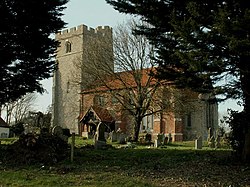Peldon
| Peldon | |
| Essex | |
|---|---|
 St Mary the Virgin parish church | |
| Location | |
| Location: | 51°48’43"N, 0°53’10"E |
| Data | |
| Population: | 559 (2011) |
| Post town: | Colchester |
| Postcode: | CO5 |
| Dialling code: | 01206 |
| Local Government | |
| Council: | Colchester |
Peldon is a village and ancient parish in the Winstree Hundred of Essex. Other nearby villages include: Little Wigborough and Langenhoe. The parish church is dedicated to St Mary the Virgin and is a Grade-I listed building. The population of the parish as of the 2011 census is 559.[1]
In 1870-72 John Marius Wilson's Imperial Gazetteer of England and Wales described Peldon as:
"Peldon, a parish and a sub-district in Lexden district, Essex. The parish lies near Mersea Island, 4½ miles S W of Wivenhoe r. station, and 5½ S by W of Colchester; and has a post-office under Colchester. Acres, 2, 186. Real property, £3, 591. Pop., 501. Houses, 106 The property is much subdivided."[2]
History
During the Iron Age and Roman periods the marshes around Peldon were home to a thriving salt-production industry, and red hills created by this process can be found around the village.[3] Peldon was originally around 2,200 acres of land, equating to approximately 8.9 square kilometres.[4] This land was established by William the Conqueror in 1086 and was later passed on to Sir Thomas Darcy by King Henry VIII. The land was later owned by various local families.[5]
The strongest earthquake to ever strike the UK occurred on the 22nd April 1884. It measured to a 5.1 magnitude on the Richter scale and rendered much of the area around and including Peldon badly damaged. In total, it damaged around 1,250 buildings including churches, houses and cottages.[6] It was reported at the time that every single building in Peldon was damaged in some way, including the local church, causing heavy financial ramifications for the local area. The Peldon Rose, the village's 15th-century inn, rumoured to have been connected by a smugglers tunnel to nearby Ray Island still exhibits earthquake damage. In 1984 a village festival was held at Kemps Farm, Peldon, to commemorate the 100th anniversary of the earthquake.
Peldon was also affected by World War One. On September the 24th 1916, German Zeppelin L33 was damaged during a bombing attack on London, and later crashed at New Hall Farm, Little Wigborough, only twenty yards from a nearby house.
The occupants of the house, the Lewis family, ran for their lives as the airship hit the ground. The crew ran from the craft and shortly after it exploded. The crew of the aircraft thought that landing in the sea would be far too dangerous, prompting the decision for them to travel further inland.
In the 1870s, Peldon's parish church was described as: "The church stands on an eminence, with commanding view; is later English, with a tower; and was restored in 1859, and then found to include remains of an early Norman church."[7]
St Mary's Church
The St Mary's Church in Peldon generally dates back to the 11th century, with Anglo-Saxon origin. The nave originates from the 12th century, the tower the 14th century, and the roof from the 16th century.[8] The church also has a tower that leans in a south-westerly direction, originally thought to have been caused by the 1884 earthquake. However, the leaning tower was reportedly already leaning when the earthquake occurred; it was noted in a book: Mehalah, a Story of the Salt Marshes (1st edition 1880). The leaning tower was actually most likely caused by subsistence due to poor ground.[9]
The church has undergone many changes throughout its existence, having been damaged during the 1884 earthquake and undergoing numerous refurbishments throughout the centuries. These refurbishments and improvements continue to this day, with charity work in Peldon taking place to raise money in order to repair and refurbish the church, a grade 1 listed building. The registered charity The Friends of St Mary's Peldon raises funds for the church, and has raised over £45,000 thus far.[10]
References
- ↑ "Parish population 2011". http://www.neighbourhood.statistics.gov.uk/dissemination/LeadKeyFigures.do?a=7&b=11127449&c=CO5+7PT&d=16&e=62&g=6424432&i=1001x1003x1032x1004&m=0&r=0&s=1443536040498&enc=1. Retrieved 29 September 2015.
- ↑ Wilson, John Marius (1870-72). "Imperial Gazetteer of England and Wales description of Peldon". http://www.visionofbritain.org.uk/place/6858. Retrieved 2 May 2017.
- ↑ de Brisay, K.W. (1978) ‘The Excavations of a Red Hill at Peldon, Essex, with notes on some other sites’ Antiquities Journal LVIII pt.1
- ↑ "History of Peldon". http://www.peldon.org/. Retrieved 29 March 2017.
- ↑ "Ownership of Peldon through time". http://www.peldon.org/. Retrieved 29 March 2017.
- ↑ "The 1884 Earthquake and its effects on Peldon and the surrounding area". http://www.peldon.org/. Retrieved 29 March 2017.
- ↑ Wilson, John Marius (1870-72). Imperial Gazetteer of England and Wales. http://www.visionofbritain.org.uk/place/6858.
- ↑ "St. Mary's Church history". http://friendsofstmaryspeldon.org.uk/history/. Retrieved 29 March 2017.
- ↑ "History of St. Mary's Church and the leaning tower". http://friendsofstmaryspeldon.org.uk/history/. Retrieved 29 March 2017.
- ↑ "Friends of St Mary's Peldon Church charity refurbishment work". http://friendsofstmaryspeldon.org.uk/. Retrieved 29 March 2017.